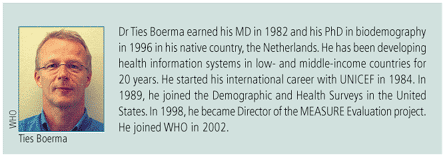WHO NEWS
Getting the numbers right

The inability to generate reliable information needed to make decisions based on evidence is a major obstacle to public health in many developing countries. When Ties Boerma became Director of WHO’s Department of Measurement and Health Information Systems in 2004, his brief was to enhance the availability, quality and use of health data. This year WHO launched the Health Metrics Network to help countries strengthen their health information systems.
Q: Why do countries need reliable health information?
A: For WHO, knowledge and evidence should be the basis of decision-making, the importance of timely, relevant quality information on health is crucial. We need information to make decisions about resource allocation, policy-making, better planning and particularly to reduce inequities in health between countries, within countries and between populations.
Q: What are health information systems?
A. There are two pillars. One is information related to provision of services: service statistics, disease surveillance and acute disease surveillance. For example: for polio, measles, etc. This includes information on human resources: where facilities are located and on budgets. The other pillar is population-based information, starting with a census which can also collect health information. This also includes vital registration. Everyone has a right to be registered with a probable cause of death, either medically certified or reached by some other method, such as verbal autopsy. Another big part of population health information is household surveys.
Q: How has health data changed?
A. WHO has always worked with health information systems. In the 1980s this was largely focused on disease surveillance and clinical information. In the 1990s, the focus shifted to population health information, for example the World Health Survey and global burden of disease work which uses data and modelling to determine the biggest public health problems. What's new is that we look at health information as a whole package. Today each country should take a strategic look at what kind of information it needs.
Q: What recent developments have spurred improvements in health information?
A. The Millennium Development Goals (MDGs) have created a unity on the international level around a specific number of goals and drawn attention to the limitations of currently available data and harmonized investments in generating data on these goals. In low-income countries where the Global Fund [to Fight AIDS, Tuberculosis and Malaria] is coming in with millions of dollars, about 57% of this can be invested in health information. The data has become important for accountability. Take the Global Alliance for Vaccines and Immunization (GAVI) which wants good data on immunization. Take the US President's emergency plan on HIV/AIDS. These are all external pressures on countries to come up with more and better data.
Q: How reliable are the figures countries provide?
A. It differs by sources. Household surveys conducted as part of high quality survey programmes such as the Demographic and Health Surveys are in line with international standards and practices and in the majority of cases these produce reliable data. But we do not blindly trust the routine health information systems data, for example, on the number of immunizations. WHO has developed different ways to check data quality.
Q: Do countries accept this is important?
A. At the moment there is a very favourable climate to building health information systems. Countries are struggling with multiple demands for data, especially from the global initiatives. They don't have the health information systems in place, it's fragmented and there is a lot of duplication.
Q: Which developing countries provide reliable data for policy-making?
A. Thailand is a good example where there has been a culture of trying to produce good data and also use them for decision-making. We have good examples at district level in Tanzania, as part of the Tanzania Essential Health Interventions Project (TEHIP), where they looked at the burden of disease due to five or six major conditions and compared that with where the district was putting its money.
Q: Why is there so little reliable data on malaria, yet it's such a big killer?
A. The first step is to have a good measurement tool. With HIV you have an antibody test. Tuberculosis is harder. You can estimate the burden of disease indirectly through tuberculin surveys or from prevalence surveys or notification rates. Malaria is harder again because you don't have a good measurement tool. You can't simply estimate prevalence or incidence by asking somebody did they have malaria, often they don't know if they had it. Diagnostic tests have improved but not enough and it is equally difficult to establish if someone has died of malaria.
Q: How is WHO helping countries to improve their health system information?
A. Working through Health Metrics Network with a broad strategy of addressing the whole array of health system, clinical and population health information is currently a priority for WHO. We also focus on weak areas such as vital statistics systems with causes of death and the basic information on health systems. Many low- and middle-income countries don't have information on distribution of services across districts and the density of facilities but also the availability of key interventions such as Caesarian section, antiretroviral treatment or human resources. We are working with Uganda, Kenya, Rwanda, Zambia and Tanzania to develop and implement a basic subnational health system monitoring system based on a WHO software package called Health Mapper. This tool generates maps and summary statistics on service availability, perhaps on a quarterly or six-monthly basis. 
